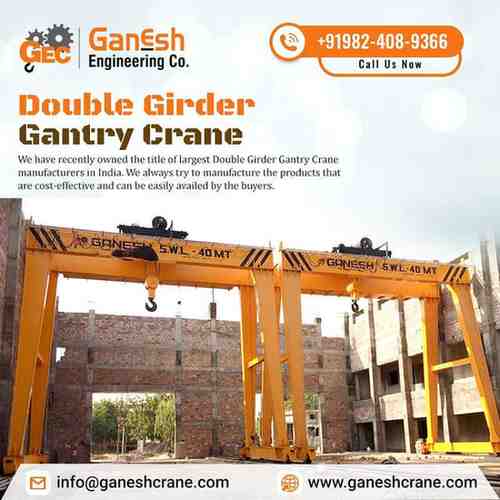In the world of material handling and heavy lifting, efficiency is the name of the game. When it comes to streamlining your operations and optimizing your workflow, single girder gantry cranes emerge as a valuable asset. These versatile machines offer a range of advantages, provided they are properly maintained.
In this blog, we’ll explore the benefits of single girder gantry cranes, delve into their essential components, and offer maintenance guidelines to ensure they operate at their peak efficiency.
Single Girder Gantry Crane – An Overview!
A single girder gantry crane, characterized by a solitary bridge girder supported by a pair of A-frame legs that glide along wheels or rails, is a popular overhead crane variant. This crane stands out for its cost-effectiveness, space-saving design, and straightforward installation process. It finds application across diverse sectors, such as manufacturing, construction, and warehousing, excelling at the precise lifting and movement of hefty loads. These cranes are available in various sizes and setups, rendering them versatile and adaptable for a broad spectrum of tasks.
Advantages of Single Girder Gantry Cranes
Cost-Effective: Single girder gantry cranes are often more budget-friendly than their double girder counterparts. Their design requires less material and labor for construction, making them a cost-effective choice for many businesses.
Versatility: These cranes are quite adaptable and may be utilized in a variety of sectors, including manufacturing and construction, as well as warehouses and shipyards. They can bear a wide range of weights and are available in a variety of configurations to meet a variety of requirements.
Space-Efficient: Single girder gantry cranes are known for their space efficiency. They require less overhead clearance than double girder cranes, making them an excellent choice for facilities with limited space.
Ease of Installation: Due to their lighter weight and simpler design, single-girder gantry cranes are easier and quicker to install compared to their double-girder counterparts. This translates to less downtime during installation.
Improved Maneuverability: These cranes offer enhanced maneuverability, making them ideal for tasks that require precise load positioning and movement. They can easily navigate tight spaces and congested work areas.
Design and Components of Single Girder Gantry Cranes
Girder: The core structural element of a single girder gantry crane is, unsurprisingly, the girder itself. This horizontal beam supports the weight being lifted and provides stability to the crane’s structure. Constructed from high-quality steel, the girder is engineered to withstand the stresses of heavy loads while maintaining its structural integrity.
Trolley: The trolley is the mechanism responsible for moving the load horizontally along the length of the girder. Equipped with wheels or runners, it ensures smooth and controlled movement of the load. Depending on the specific requirements, trolleys can be manually operated or powered, allowing for greater precision and efficiency.
Hoist: The hoist is the component that performs the actual lifting and lowering of the load. It comprises a motor, a set of gears, and a hook or lifting attachment. Single girder gantry cranes are versatile in this aspect, as the hoist can be electric or manual, depending on the load capacity and operational needs.
End Trucks: The end trucks are the structures located at the ends of the girder. These house the wheels or runners that facilitate the movement of the crane along the gantry’s supporting legs or rails. Sturdy and well-designed end trucks are crucial for the crane’s stability and smooth operation.
Controls: Modern technology has given rise to advanced control systems for single-girder gantry cranes. These controls enable operators to maneuver the crane with precision and safety. From basic push-button controls to more sophisticated radio remote control systems, the range of options allows operators to choose the most suitable method for their operations.
Guidance on Routine Maintenance & Inspection of Single Girder Gantry Cranes
Routine maintenance and regular inspections are essential for keeping cranes safe and working well. So, follow the below tips and guidelines to keep your cranes maintained in the long run:
Routine Maintenance:
Keep it clean: Dust and dirt can mess up a crane’s moving parts. Therefore, you should regularly clean the crane to prevent it from dirt.
Lubricate moving parts: Just like your bike needs oil on its chain, cranes have parts that need grease. Lubricating your crane’s components helps them move smoothly.
Check for loose bolts: Over time, nuts and bolts of cranes can become loose. So, you need to tighten them from time to time but make sure to not over-tighten them.
Inspect wires and cables: Look for any frayed or damaged wires. If you see any, they need to be replaced.
Test brakes: Make sure the brakes work well. You don’t want the crane to move when you don’t want it to.
Look for leaks: If you see any oil or hydraulic fluid leaking, that’s a problem. It needs fixing right away.
Regular Inspections:
Weekly checks: You should inspect your crane every week. Also, you should look for any obvious problems and make sure everything works as it should.
Monthly inspections: These should be more detailed. Check the crane’s electrical systems, safety devices, and any signs of wear and tear.
Annual inspections: Once a year, get a professional to do a thorough inspection. They’ll check everything, including load-testing the crane to ensure it can handle heavy weights. Many top Single Girder Gantry Crane Suppliers in India offer after-sale service also.
Why is this important?
Safety: Regular maintenance and inspections keep the crane safe to use. You don’t want accidents to happen.
Longevity: Like any machine, if you take care of a crane, it will last longer. Replacing a crane is expensive, so it’s smart to make it last as long as possible.
Efficiency: A well-maintained crane works better and gets the job done faster. That’s good for business.
Remember, safety comes first. If you ever notice something wrong with the crane, stop using it and get it checked by a professional.
Conclusion
In this article, you learned about single girder gantry cranes, their components, advantages, and maintenance procedures. If you want to buy high-quality cranes, you can consider buying from Ganesh Crane. As one of the leading Single Girder Gantry Crane Manufacturers in India, we believe in the efficiency and effectiveness of our products, and our dedication is evident in our design, manufacturing, and service. For more details about these gantry cranes, visit our website now.


